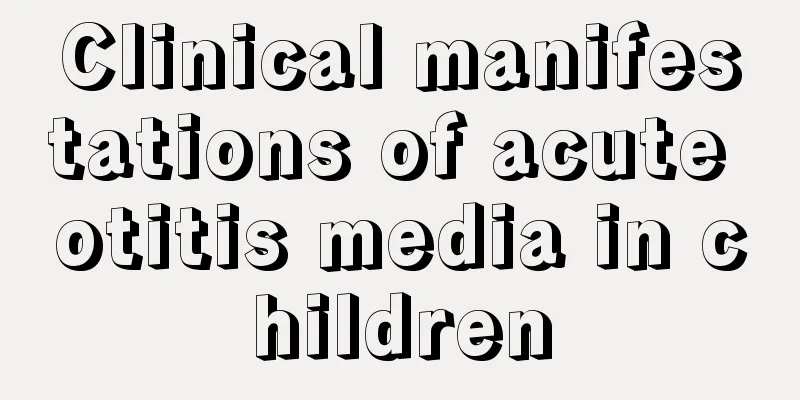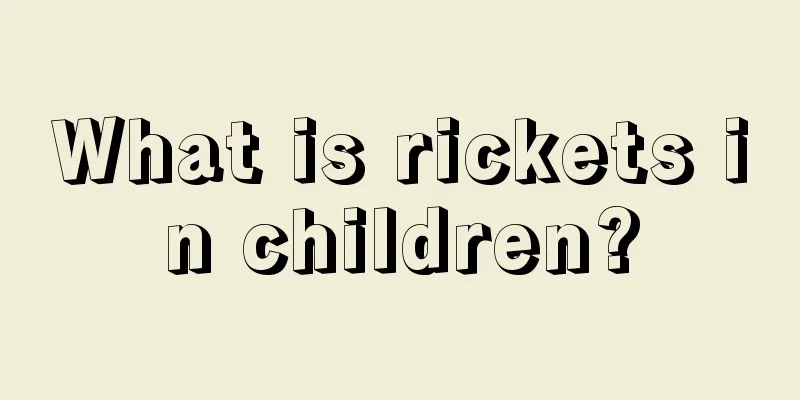Clinical manifestations of acute otitis media in children

|
We know that children are more prone to various diseases because their body's resistance to disease is not as strong as that of adults. We must be very cautious in helping children treat diseases to avoid causing harm to children's bodies due to improper use of drugs. Otitis media is a common ear disease. It occurs not only in adults but also in children. Below we introduce the clinical manifestations of acute otitis media in children. Acute otitis media may have systemic symptoms such as chills, fever, fatigue and loss of appetite. Children often have gastrointestinal symptoms such as vomiting and diarrhea. Once the eardrum is perforated, the body temperature will gradually drop and systemic symptoms will be significantly alleviated. Earache is the most common manifestation of acute suppurative otitis media in children. It is often pain deep in the ear that gradually worsens, such as throbbing or stabbing pain. The earache worsens when swallowing and coughing. Children often become irritable and unable to sleep at night because of this. After the eardrum perforated and pus discharged, the ear pain was relieved immediately. Otorrhea occurs after perforation of the tympanic membrane. It is initially bloody and then becomes mucopurulent. Hearing loss is often mild and is often masked by severe ear pain. In the early stage of physical examination, congestion can be seen in the flaccid part of the tympanic membrane, and radially dilated blood vessels can be seen around the handle of the malleus and the tense part. Then the tympanic membrane becomes diffusely congested, swollen, and bulges outward, making normal signs difficult to recognize. Before the tympanic membrane perforates, small yellow spots appear locally. At the beginning, the perforation is small and difficult to see clearly. Sometimes, there are flickering and pulsating bright spots on the surface of the eardrum. Then the perforation becomes larger and pus is discharged. There is tenderness in the mastoid area, and children are often uncooperative with hearing tests. Conductive hearing loss can be detected in older children. Blood examination can reveal an increase in the total white blood cell count and neutrophil granulocyte count, and the blood count may return to normal after tympanic membrane perforation. Chronic otitis media is characterized by long-term pus discharge from the ear, which may be more or less in amount and may sometimes be accompanied by bleeding and a foul odor. Perforation of the pars flaccida or pars tense of the tympanic membrane may sometimes result in the observation of granulation tissue or cholesteatoma epithelium in the tympanic cavity or external auditory canal. Hearing tests generally show varying degrees of conductive hearing loss. Hearing loss is a common manifestation of secretory otitis media in children. Hearing loss is usually mild, and children are insensitive to sounds and usually do not report hearing loss. They are often brought to the doctor by their parents because of poor concentration and poor academic performance. If one ear is affected, it may not be noticed for a long time and may only be discovered during a physical examination. A feeling of stuffiness in the ears and tinnitus are also common clinical manifestations of this disease, which can be temporarily relieved by pressing the tragus. Examination revealed that negative pressure in the tympanic cavity caused the flaccid part or the entire tympanic membrane to recede, the handle of the malleus shifted posteriorly and superiorly, and the short process of the malleus protruded outward; when fluid accumulates in the tympanic cavity, the tympanic membrane loses its normal luster and becomes light yellow or amber, and sometimes the fluid level can be seen through the tympanic membrane. Tuning fork test and pure tone audiometry showed conductive hearing loss. The degree of hearing loss varies, and in severe cases it can reach around 40dBHL. Hearing improved immediately after the effusion was drained. Acoustic impedance is of great value in diagnosis. The flat type is the typical curve of otitis media with effusion, and the high negative pressure type shows poor Eustachian tube function and some tympanic effusion. In the above article, we introduced a disease that may occur in children, that is, acute otitis media. We know that acute otitis media can easily cause many troubles to children, so children must do a good job of preventing acute otitis media. The above article introduces in detail the clinical manifestations of acute otitis media in children. |
<<: What are the dangers of enlarged tonsils in children?
>>: What's the matter with the little red spots on my face that itch a little?
Recommend
What anti-inflammatory medicine should a child take if he has a fever after tooth extraction?
Tooth extraction is actually a very normal minor ...
What can children eat to grow taller?
In real life, many parents are concerned about th...
What is the cause of yellow spots on children’s teeth?
If people's teeth turn yellow, they will feel...
Is it right to drink apple water when the baby is constipated?
Constipation is a common disease. Not only adults...
How to correct stuttering in children
Stuttering is the constant repetition of words or...
What to eat for children with stomachache
What should children eat when they have stomachac...
What medicine should children take if they have worms in their stomach?
Nowadays, the living and sanitary environments ha...
Why does my baby's knees make noises?
The baby's health concerns the whole family, ...
How long after feeding should the baby take a bath
After birth, whether the baby is fed with breast ...
What is the cause of blood in the urine of children?
When a child has physical problems, parents shoul...
The child has an abscess on his gums
Dental health has always been a concern for paren...
What to do if your child doesn't sleep at night
Children are definitely different from adults. Th...
What should I do if my child is allergic to fish?
People usually eat a variety of fish, the most co...
Is it normal for a baby to not have a rash?
Roseola is a common rash in infants and young chi...
The top 6 behaviors that children dislike their parents
It is a sad thing that due to the lack or inappro...









